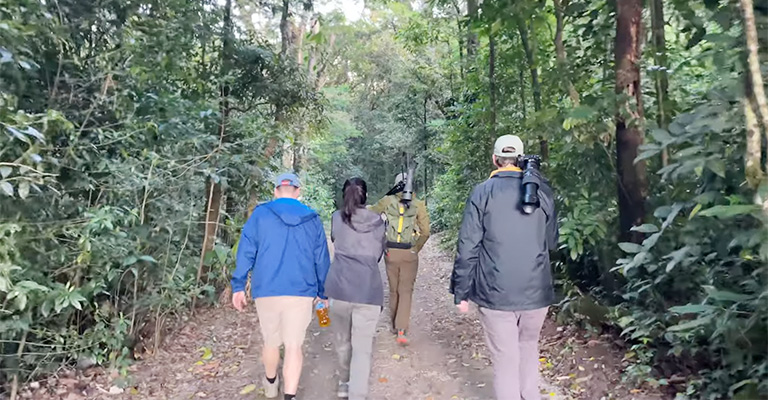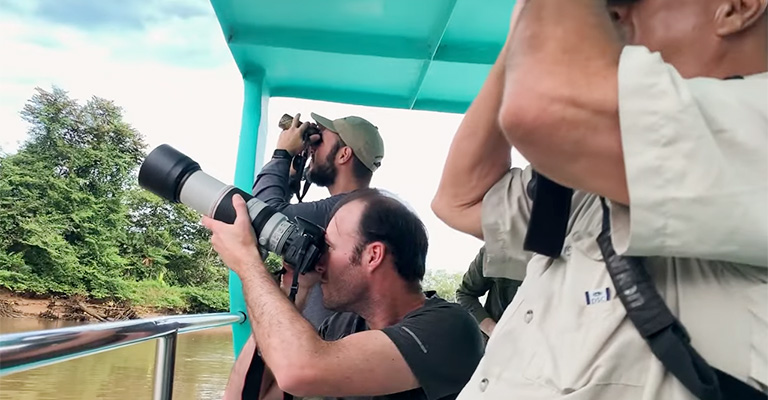Costa Rica, a small Central American country known for its rich biodiversity, has gained international recognition for its remarkable sustainability efforts.
With a commitment to preserving its natural resources and protecting its diverse ecosystems, Costa Rica has become a haven for bird-watching enthusiasts from around the world.
This article explores how has Costa Rica’s sustainability efforts impacted bird-watching tourism. Costa Rica’s dedication to conservation has resulted in the preservation of vast areas of pristine rainforests, cloud forests, and wetlands, providing a habitat for over 900 bird species.
The country’s extensive network of national parks and protected areas offers bird watchers unparalleled opportunities to observe a wide variety of avian species in their natural habitats.
Furthermore, Costa Rica’s sustainable practices have created a harmonious environment for birds and other wildlife. This has not only enhanced the bird-watching experience but also attracted eco-conscious travelers. Let’s explore more!

How Has Costa Rica’s Sustainability Efforts Impacted Bird-Watching Tourism?
Costa Rica is renowned for its commitment to sustainability and conservation. Here’s how Costa Rica’s sustainability initiatives have influenced bird-watching tourism, highlighting the positive outcomes and benefits:
Preservation of Natural Habitats
Costa Rica’s sustainability efforts have focused on preserving and restoring natural habitats, which has directly benefited bird populations.
The country boasts an impressive array of ecosystems, including rainforests, cloud forests, mangroves, and wetlands, which serve as crucial habitats for numerous bird species.
By protecting these habitats, Costa Rica has created ideal conditions for bird-watching enthusiasts.
Increased Bird Diversity
Due to its diverse range of ecosystems, Costa Rica is home to an astonishing variety of bird species. The country has over 900 bird species, including the resplendent quetzal, scarlet macaw, and toucan.
By prioritizing conservation, Costa Rica has managed to maintain and even increase its bird diversity. This has attracted bird-watchers from around the world who are eager to observe and photograph these magnificent creatures in their natural habitats.
Development of Bird-Watching Infrastructure
Costa Rica’s sustainability efforts have also led to the development of bird-watching infrastructure, such as nature reserves, national parks, and birding trails.
These protected areas provide safe havens for birds and offer visitors the opportunity to explore and appreciate Costa Rica’s avian wonders.
The country has established several birding hotspots, including Monteverde Cloud Forest Reserve, Tortuguero National Park, and La Selva Biological Station, which have become popular destinations for bird watchers.
Community Involvement and Ecotourism
Costa Rica’s sustainability initiatives have emphasized community involvement and the promotion of ecotourism. Local communities have been actively engaged in conservation efforts, including bird monitoring, habitat restoration, and eco-friendly practices.
This collaboration has not only helped protect bird populations but has also created economic opportunities through bird-watching tourism. Local guides, lodges, and tour operators cater to bird watchers, providing them with expert knowledge and immersive experiences.
Educational and Research Opportunities
Costa Rica’s commitment to sustainability has also fostered educational and research opportunities in the field of ornithology. The country’s rich bird diversity and conservation efforts have attracted scientists, researchers, and students from around the world.
These individuals contribute to ongoing studies, monitoring programs, and conservation projects, further enhancing our understanding of avian ecology and behavior.
Protected Areas and Conservation Programs
Costa Rica has established a network of protected areas, including national parks, wildlife refuges, and biological reserves, covering approximately 25% of its land area.
These protected areas serve as crucial habitats for birds, providing them with food, shelter, and breeding grounds.
The government has implemented conservation programs to monitor and protect bird populations, ensuring their long-term survival.
Sustainable Tourism Practices
Costa Rica has embraced sustainable tourism practices, which have positively influenced bird-watching tourism.
Eco-lodges and hotels in birding hotspots have adopted environmentally friendly practices, such as using renewable energy sources, minimizing waste, and promoting responsible tourism.
This approach aligns with the values of bird watchers who seek to minimize their impact on the environment while enjoying their bird-watching experiences.
Costa Rica’s Promotion of Eco-Tourism

Costa Rica’s approach to eco-tourism promotion revolves around preserving its natural beauty, involving local communities, and fostering a sense of responsibility among visitors to protect the environment. Here are the details:
Sustainable Practices
Costa Rica has actively embraced sustainable practices in its tourism industry. The government and local businesses focus on minimizing the negative environmental impact of tourism by implementing regulations and guidelines that prioritize eco-friendly operations.
Biodiversity Preservation
The country’s rich biodiversity is a major draw for eco-tourists. Costa Rica promotes eco-tourism by preserving its natural habitats, national parks, and wildlife reserves.
Visitors are encouraged to explore these areas while adhering to strict rules that safeguard the ecosystems.
Community Involvement
Costa Rica involves local communities in eco-tourism initiatives, ensuring that economic benefits are distributed widely.
Community-based tourism projects allow tourists to experience local cultures while supporting the livelihoods of residents.
Education and Awareness
The government and various organizations in Costa Rica conduct educational programs and workshops for both tourists and locals. These efforts aim to raise awareness about environmental conservation, wildlife protection, and responsible travel practices.
Certification Programs
Certification programs like the Certification for Sustainable Tourism (CST) have been established to assess and recognize accommodations, tour operators, and other tourism-related businesses that adhere to sustainable practices. This helps tourists make eco-conscious choices.
Adventure Eco-Tourism
Costa Rica promotes adventure activities like hiking, zip-lining, and canopy tours that allow tourists to engage with nature in an environmentally sensitive manner. These activities often include educational components about the local ecosystems.
Eco-Lodges and Accommodations
The country offers a range of eco-lodges and sustainable accommodations that are designed to have minimal impact on the environment. These lodges often use renewable energy sources, practice waste reduction, and support local communities.
Carbon Neutrality Goals
Costa Rica has set ambitious goals to achieve carbon neutrality. This commitment aligns with its eco-tourism promotion efforts, as travelers are drawn to destinations that prioritize environmental sustainability.
Wildlife Tourism Guidelines
To prevent disturbance to wildlife, Costa Rica has established strict guidelines for wildlife tourism. Tour operators and guides are trained to ensure that interactions with animals are respectful and do not harm their natural behaviors.
Reforestation Initiatives
The government and NGOs in Costa Rica run reforestation projects to restore and expand natural habitats. Tourists are sometimes encouraged to participate in tree-planting activities, fostering a deeper connection with environmental conservation.
Top Birding Destinations in Costa Rica

Costa Rica is a paradise for bird enthusiasts, offering a diverse range of habitats that support an incredible variety of bird species. Here are some of the top birding destinations in Costa Rica:
Monteverde Cloud Forest Reserve
This renowned cloud forest is home to the resplendent quetzal, a bird that’s a highlight for many birders. The reserve’s misty environment harbors a plethora of other bird species, making it a must-visit spot.
Corcovado National Park
Located on the Osa Peninsula, Corcovado is a hotspot for biodiversity. It’s an excellent place to spot scarlet macaws, toucans, various parrot species, and even the harpy eagle, one of the world’s largest and most powerful eagles.
La Selva Biological Station
Situated in the lowland rainforest, La Selva is part of a UNESCO Biosphere Reserve. It’s home to a rich array of bird species including great green macaws, king vultures, and a wide variety of toucans and trogons.
Arenal Observatory Lodge
With the imposing Arenal Volcano as a backdrop, this lodge offers opportunities to spot raptors, including the majestic hawk-eagle. You can also find hummingbirds, tanagers, and various flycatcher species.
Tortuguero National Park
This park’s intricate system of canals and waterways is a haven for waterbirds such as herons, egrets, anhingas, and boat-billed herons. It’s also a prime nesting site for various sea turtles.
Carara National Park
This park acts as a transition zone between the drier northwest and the wetter southwest, leading to a mix of bird species from both regions. It’s a good place to spot scarlet macaws and various species of trogons.
Manuel Antonio National Park
Besides its stunning beaches, this park is home to numerous bird species, including toucans, parrots, motmots, and the fiery-billed aracari.
Rincon de la Vieja National Park
This park in the Guanacaste region offers a chance to see the crested guan, a large turkey-like bird, as well as various woodpecker and raptor species.
Tapanti National Park
Known for its lush vegetation, this park is great for birding due to the presence of species like the black guan, quetzals, and multiple hummingbird species.
Cano Negro Wildlife Refuge
This wetland area is home to numerous waterfowl species, including ibises, ducks, and roseate spoonbills. It’s a prime spot for observing both resident and migratory birds.
Costa Rica’s Ecological Diversity and Habitats

Costa Rica boasts remarkable ecological diversity and a variety of habitats due to its unique geographical location and varying climate zones. Here are some key aspects of its ecological diversity and habitats:
Biodiversity Hotspot
Costa Rica is considered one of the world’s biodiversity hotspots. Despite its relatively small size, the country is home to around 5% of the world’s known species.
This incredible diversity is attributed to its position as a bridge between North and South America, allowing for the mingling of species from both continents.
Rainforests
The country is renowned for its lush tropical rainforests, which are teeming with diverse flora and fauna. These forests are found in areas with high rainfall and humidity.
Cloud Forests
Costa Rica’s higher elevations give rise to cloud forests, where the misty environment supports a unique assemblage of plants and animals. These forests are characterized by a constant layer of clouds that provides moisture to the ecosystem.
Dry Forests
In contrast to its wetter regions, Costa Rica also has dry forests in areas with lower rainfall. These habitats host species adapted to survive with less water, and they contribute to the country’s overall ecological diversity.
Mangroves and Wetlands
Mangroves and wetlands are essential ecosystems for various reasons. They serve as nurseries for juvenile marine life, act as buffers against coastal erosion, and provide important habitats for resident and migratory bird species.
Volcanic Landscapes
Costa Rica’s geological history has left it with a series of volcanoes, some of which are active. These volcanic landscapes contribute to the country’s diverse ecosystems, creating fertile soils that support a wide range of plant and animal life.
National Parks and Reserves
To protect its rich biodiversity, Costa Rica has established numerous national parks and reserves. These protected areas encompass a variety of habitats and offer a haven for countless species, making them ideal destinations for eco-tourism and research.
Highland Meadows and Paramo
In higher altitudes, you’ll find alpine meadows and paramo, which are unique to the region. These areas are characterized by grasses, shrubs, and distinctive flora adapted to the cooler temperatures.
FAQs
Costa Rica’s sustainable practices include maintaining national parks, promoting community-based ecotourism, and implementing strict wildlife protection regulations. These efforts create stable environments for birds and reduce disturbances.
Costa Rica’s emphasis on preserving biodiversity benefits bird-watching tourism by providing a rich variety of bird species to observe. The preservation of natural habitats ensures that bird-watchers have the opportunity to see a wide range of birds, from vibrant toucans to elusive quetzals.
Sustainability initiatives help maintain the pristine environments that birds require for breeding, feeding, and nesting. This, in turn, creates optimal conditions for bird-watchers to observe birds in their natural behaviors.
Yes, Costa Rica’s reputation as a sustainable and eco-friendly destination has attracted a growing number of bird-watching tourists. Travelers who are passionate about both bird-watching and responsible travel are drawn to Costa Rica’s commitment to preserving natural habitats.
Local communities benefit economically from sustainable bird-watching tourism through employment opportunities in eco-tourism ventures, lodges, and guiding services. Additionally, community involvement in conservation efforts ensures that residents become stewards of their natural surroundings.
Bottom Line
Costa Rica’s sustainability efforts have had a profound impact on bird-watching tourism. By prioritizing conservation and implementing sustainable practices, Costa Rica has become a haven for bird enthusiasts.
The country’s commitment to preserving its rich biodiversity has resulted in the protection of crucial habitats for numerous bird species, making it a prime destination for bird-watching.
Costa Rica’s sustainable initiatives, such as the establishment of national parks and protected areas, have not only safeguarded the natural habitats of birds but have also created opportunities for eco-tourism.
Bird-watching tours and lodges that adhere to sustainable practices have flourished, providing visitors with unforgettable experiences while minimizing their ecological footprint.
Moreover, Costa Rica’s sustainability efforts have raised awareness about the importance of conservation among both locals and tourists.
This increased environmental consciousness has led to a greater appreciation for birds and their habitats, fostering a sense of responsibility for their protection.